Nablai's Nebula
With eight months into the year, August is finally here. It feels like just yesterday and I'm amazed at how fast time flew. Well, that's the beauty of time--it keeps going on. A hope for the better makes us change ourselves best. It's the efforts that define us, even though they might be miniscule in sight. Keep at it--you've got this!
This month's sub-genre is Hollow Earth, which is the second part of A Different World series trilogy at the Tevun-Krus. July was Flat Earth, August has Hollow Earth, and stay tuned for September.
As the name suggests, the concept of Hollow Earth is that our Earth is entirely hollow or consists of a considerable inner space. Joseph Wright of Derby's painting in the 1780s uses a cave's mouth as a stony frame for a view over the Gulf of Salerno.

The notion was first put forward by astronomer Edmond Halley in the late 17th century (1692 to be exact). He believed that as the earth was hollow, its magnetic fields were being thrown off by three inner "shells" within the Earth, combined with its own magnetic poles. The shells were "lined throughout with a Magnetical Matter, or rather to be one great Concave Magnet" to hold the shell as magnetism is a much stronger force than gravity.
In 1740. Pierre Bouguer suggested the same theory and there was Charles Hutton around 1774, conclusively propagating the Hollow Earth concept in his Schiehallion experiment.
The concept is a recurring theme in folklore and acts as a strong base for subterranean fiction, a subgenre of adventure fiction.

Edmond Halley wasn't the first to postulate about Hollow earth. Infact, it was initially introduced by Athanasius Kircher's non-fiction "Mundus Subterraneus" (1665), where it hypothesized that there's an "intricate system of cavities and a channel of water connecting the poles."

Then also, Le Clerc Milfort in 1781 lead a journey with hundreds of Muscogee Peoples to a series of caverns near the Red River above the junction of the Mississippi River and claimed their ancestors emerged from there.
It was claimed that the mathematician Leonhard Euler had proposed there was a single-shell hollow Earth with a small sun at the center, providing light and warmth for an inner-Earth civilization.
One of the strongest proponents of the Hollow Earth concept was John Cleves Symmes, Jr. in 1818, who suggested an expedition to the North Pole with the efforts of one of his followers- James McBride. There was Jeremiah Reynolds who delivered lectures on the "Hollow Earth" and went on an expedition to Antarctica.
There are many who published books regarding the Hollow Earth theory. Prominent amongst them are:
James McBride's "Symmes' Theory of Concentric Spheres" (1826), William Fairfield Warren in "Paradise Found–The Cradle of the Human Race at the North Pole" (1885) presented his belief that humanity originated on a continent in the Arctic called Hyperborea and there was "The Hollow Earth" by Raymond Bernard (1979).
This idea has inspired art forms like Caragh Thuring's 2018 painting "Inferno" that shows a party of Grand Tourists in Georgian dress balanced on a lip of a crater, silhouetted against a golden plane of lava, a fantastical composition that reminds us of the enduring taste for danger, the thrill of threat.

Many novels are based on the Hollow Earth theory. I'm sure many of you have read "Journey to the Center of the Earth" (1864) by Jules Verne.
Hollow Earth: The Book of Beasts by John Barrowman and Carol E. Barrowman

Matt and Emily Calder's travels through time come to a thrilling conclusion in the third book of the Hollow Earth trilogy as the siblings struggle to close Hollow Earth—and keep the monsters inside.
The Descent by Jeff Long

We are not alone ...
In a cave in the Himalayas, a guide discovers a self-mutilated body with the warning "Satan exists".
In the Kalahari Desert, a nun unearths evidence of a proto-human species and a deity called Older-than-Old.
In Bosnia, something has been feeding upon the dead in a mass grave.
So begins mankind's most shocking realization: that the underworld is a vast geological labyrinth populated by another race of beings. Some call them "devils" or "demons." But they are real. They are down there. And they are waiting for us to find them...
No talk of Hollow Earth would be complete without mentioning movies like Children Who Chase Lost Voices, Ice Age: Dawn of the Dinosaurs, Aquaman, MonsterVerse; some television programs such as Inside Job, Slugterra, and the third and fourth seasons of Sanctuary; a couple of role-playing games namely the Hollow World Campaign Set for Dungeons & Dragons, Hollow Earth Expedition; and video games like Torin's Passage and Gears of War. This hypothesis is partially used in the Marvel Comics universe, where Subterranea is a subterranean realm existing beneath the Earth.
The SNES video game Terranigma also features this idea in the opening and closing scenes of the game.
This is all for now. We meet in September with another exciting issue.
Love you and take care ❤️ Kind regards, Nab =]
Bạn đang đọc truyện trên: AzTruyen.Top